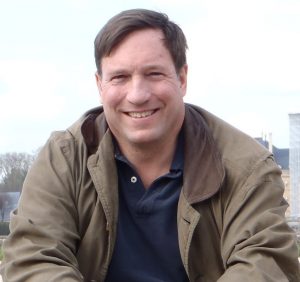Buildings and the Connection to Nature (01:12)
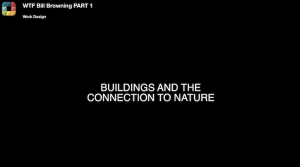
Hi, I’m Bill Browning. I’m Managing Partner of Terrapin Bright Green. Terrapin is a small research and consulting firm. Our work is largely focused on green buildings, advanced green building strategies, biomimicry, looking at innovation inspired by nature. We also are really interested in how the space impacts the people itself. Metrics around a focus of biophilia, human connection with nature and how experiences of nature can be brought into the built environment.
It’s About the Experience (1:43)

In particular, we’re interested in how people use the building and how they use the space, but then also how that space impacts them. When we think about the cost of energy for square foot and the operating cost of a building, and that’s really important for economics and also for the carbon implications, but the real cost of the building is the people. And so if I look at do a pie chart for a typical office building, over 90% of the cost per square foot per year are the people. Or if I flip that around when I add in absenteeism and presenteeism, 1% gain in productivity is equivalent to the entire energy bill. And so focusing on the experience of the people is really, really important to us. We also realize that in an office you don’t have just sort of one kind of user. You have multiple people having different experiences in it, and so some of it is just the first step is sort of mapping understanding who are the people who are going to be using this space and what are their needs?
Return to Office (02:54)
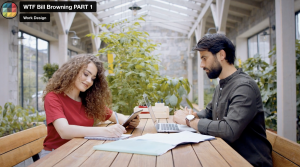 One of the things that we’re seeing is more companies going to committing and deepening the biophilic experiences partially as a way to create more interesting places to come back to work. Do you want to just come back to the normal workstation? I don’t think so, right? I want to have a different experience and I also want to have an experience that I can’t have at home. Making these changes and doing these strategies, hopefully you’re making a workplace that is more attractive and one that people are more likely to want to come back to experience.
One of the things that we’re seeing is more companies going to committing and deepening the biophilic experiences partially as a way to create more interesting places to come back to work. Do you want to just come back to the normal workstation? I don’t think so, right? I want to have a different experience and I also want to have an experience that I can’t have at home. Making these changes and doing these strategies, hopefully you’re making a workplace that is more attractive and one that people are more likely to want to come back to experience.
Connection to Nature (3:32)
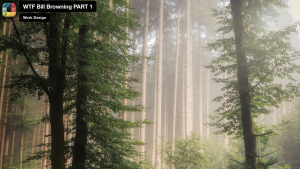
Biophilia is about human connection to nature. When you first mention it, people think, oh, great, I’m going to put a bunch of plants in the space, but there are lots of other experiences of nature that I can bring into the building. I can bring daylight in, I can bring natural breezes in. I can use natural materials. I can bring in patterns that have biomorphic forms in them, which we know lower stress or use patterns that occur a lot in nature called statistical fractals, which are mathematically repeating patterns that occur all over the place in nature and when we see them in human designed objects, it lowers our stress. We can also look at the spatial experiences themselves.
If I am in a space where I have an unimpeded view in the distance that’s called prospect and that’s good for wayfinding perceptions of safety and we know that that’s good for stress reduction. We also look for places that create a condition called “refuge” where my back is protected and I may have some canopy overhead. That could be as simple as a big wing back chair. Could be a niche along a wall, it can be a phone booth as long as that’s set up in a way that the doors to my side not to my back. One of our favorites would be high back booths like in a restaurant. And if I am in that space and I have a view out across the rest of the space, now I have prospect and refuge together.
Nature in the Space (5:06)
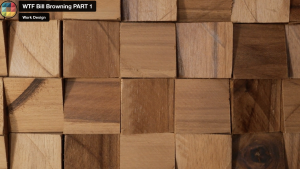 We’ve identified that there are kind of 15 different experiences of nature that we can translate into the built environment as a pattern language. It’s not a pattern language of objects though it’s a pattern language of experiences. The first category we call ‘nature in the space’, and so these are direct experiences of nature that I can have in the built environment. The first one is making a visual connection to nature. Do I have a view to nature outside? Do I have a view to nature inside? It can even be a painting of nature or a video of nature, both of which we know will lower blood pressure and heart rate not as much as the real thing, but enough to make a significant difference.
We’ve identified that there are kind of 15 different experiences of nature that we can translate into the built environment as a pattern language. It’s not a pattern language of objects though it’s a pattern language of experiences. The first category we call ‘nature in the space’, and so these are direct experiences of nature that I can have in the built environment. The first one is making a visual connection to nature. Do I have a view to nature outside? Do I have a view to nature inside? It can even be a painting of nature or a video of nature, both of which we know will lower blood pressure and heart rate not as much as the real thing, but enough to make a significant difference.
Non-visual connection to nature, sounds of nature, smells, tactile experience. We’re also interested in variability of light, both circadian light changes over the course of the day, but also shade and shadow and changes in light in the space; that keeps us much more engaged and alert. Having a variety of thermal conditions and airflow, water in a space is really, really powerful. The presence of water and not just visually seeing water, but the sound of water in particular is by far the most effective masking sound I can put in the space. Not from a pure acoustic standpoint. White noise is more effective as an acoustic masking technique, but in the brain psychoacoustics. The difference between acoustics and psychoacoustics, is acoustics tells us what’s coming to our ear, and psychoacoustics tells us what the brain’s actually choosing to listen to. And so water sound is by far the most effective masking sound I could ever introduce into a space. Also, just being able to see the changes in nature and seeing natural processes, so connection to nature.
Natural Analogs (07:09)
 The next category we call natural analogs, and these are indirect experiences of nature. Things like using patterns in biomorphic forms using natural materials, and we’re not sure why, but the brain sorts between alive and manmade subconsciously almost instantaneously, and there’s a very strong preference for the natural. Then complexity in order. If a space is just too ordered, it’s boring, and if it’s too complex, it’s overwhelming. There’s a balance in between there, and this is where in particular, where the use of fractals falls in and gets really interesting.
The next category we call natural analogs, and these are indirect experiences of nature. Things like using patterns in biomorphic forms using natural materials, and we’re not sure why, but the brain sorts between alive and manmade subconsciously almost instantaneously, and there’s a very strong preference for the natural. Then complexity in order. If a space is just too ordered, it’s boring, and if it’s too complex, it’s overwhelming. There’s a balance in between there, and this is where in particular, where the use of fractals falls in and gets really interesting.
Nature of Space (7:51)
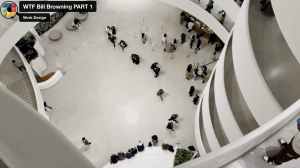
The third category, what we call nature of the space, and these are the three dimensional spatial experiences. We have four patterns in that category. The first two we’ve talked about prospect, the unimpeded view through space refuge where my back is protected. It may have some canopy overhead, but it’s a place where I can withdraw temporarily and sort of refocus and rebalance. Mystery where some of the researchers call it enticement. So that’s that curving path, that curving hallway where I just want to see what’s around the corner. That can also be done with sound, can be done with the light, can be done with smell, right? You’re walking down the street and you smell those cookies at the bakery. Then the next pattern is one, you don’t want to use too much, but a really fun one called risk peril. One of my favorite examples, not an office building, but a Frank Lloyd Wright building, the Guggenheim Museum in New York has that curving ramp, the central atrium, and if you get to the top and you look over, it’s pretty exhilarating to look into that central atrium, but it’s even more exhilarating because Wright intentionally makes that railing just a little bit low. That elicits that a risk peril experience. You’re not going to fall, but it is a little more exhilarating, and so that actually elicits a strong dopamine plasia response in the brain.
And then the final pattern is coming in under the dark narthex into a cathedral and then suddenly coming into the nave and it explodes up around you and you just stop and your eyes go wide and your mouth drops open and you’re having an experience of awe.
Each of those different spatial conditions triggers a response in a different portion of the brain. In the awe experience, the medial prefrontal cortex is overloaded, and so that’s why you see the whole body just sort of pause and in all experience, like coming to the edge of the Grand Canyon can be somewhat of a fear experience, but the body’s physiological response is not a fear response. It’s the whole body just sort of goes on pause, heart rate slows down, blood pressure lowers the noles in your face goes slack. The look is all of that happening while your brain processes it and re-accommodates.
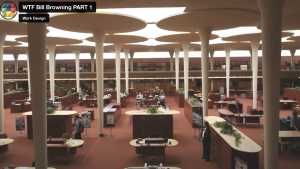 Each of the 15 different patterns elicits different responses. Some of them are good for stress reduction. Other of those 15 patterns help with cognitive performance. Some of them help with mood, and in the case of awe, it triggers several of those, but most importantly, it also triggers better pro-social behavior, which is unique to that pattern and we find quite fascinating. My favorite use of awe in an office building is again, Frank Lloyd Wright. The Johnson Wax administration building has this stunning central space where the majority of a lot of the workstations are. It has these columns that have been called the lily pads, but they are really basically trees like trees in a Savannah, which is an ecosystem that we respond to very strongly in a positive way, but like a lot of Wright buildings, you don’t come to that space directly. You enter under a low port cosha, you go down a corridor with a water feature on your right, it’s low and it’s contained, and you go past some other spaces, but then you come to this brick shape that’s actually an elevator core, you’re seeing the back of it, and you go around that and you come out underneath the balcony and you come into that space, and so that’s what right called ‘compression and release’. He said, when you come into that grand space, you stop, and the first time you experience that, you have that awe experience. And it’s interesting. The awe experience is something that has been used in religious architecture worldwide, and there was an interesting experiment where they had people have an experience, then have an awe experience, and after both of the experiences they sent around a donation basket, after people have the awe experience, they put more money in the basket.
Each of the 15 different patterns elicits different responses. Some of them are good for stress reduction. Other of those 15 patterns help with cognitive performance. Some of them help with mood, and in the case of awe, it triggers several of those, but most importantly, it also triggers better pro-social behavior, which is unique to that pattern and we find quite fascinating. My favorite use of awe in an office building is again, Frank Lloyd Wright. The Johnson Wax administration building has this stunning central space where the majority of a lot of the workstations are. It has these columns that have been called the lily pads, but they are really basically trees like trees in a Savannah, which is an ecosystem that we respond to very strongly in a positive way, but like a lot of Wright buildings, you don’t come to that space directly. You enter under a low port cosha, you go down a corridor with a water feature on your right, it’s low and it’s contained, and you go past some other spaces, but then you come to this brick shape that’s actually an elevator core, you’re seeing the back of it, and you go around that and you come out underneath the balcony and you come into that space, and so that’s what right called ‘compression and release’. He said, when you come into that grand space, you stop, and the first time you experience that, you have that awe experience. And it’s interesting. The awe experience is something that has been used in religious architecture worldwide, and there was an interesting experiment where they had people have an experience, then have an awe experience, and after both of the experiences they sent around a donation basket, after people have the awe experience, they put more money in the basket.
Scent is Powerful (12:25)

What we’ve learned in the last few years, there’ve been some interesting pieces of science. One of the first one came out of Japan, and that was a look at, and they used mice for this originally because they wanted to track what was happening in their brain, and they used linalool, which is the predominant compound in the scent of lavender. You always hear, oh, lavender’s calming, turns out at least in mice, and it appears to be the same in humans, is that that compound linalool triggers the same neural pathways in the brain as Valium, and unlike Valium, you don’t get habituated to it. Certain sense, certain smells trigger different pathways in the brain and trigger different responses, and since also interesting as a sense, it’s the one that actually we respond fastest to. We process that quicker than we process anything else much quicker than vision. Vision’s actually pretty slow, so by the time we process it, the event is already happened. We just don’t realize that. Scent goes through the brain really, really fast. It also triggers memories in ways that some of the other senses don’t so. Sense is an interesting one, and particularly if we can then combine different sensory experiences, so sound and smell and touch along with the visual. Much of our brain processing is focused on visual. We’re highly visual critters, but the experiences are more powerful if we can combine senses together.
What’s Next? (14:09)
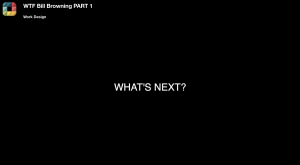 Increasingly, we’re doing some digging around and trying to understand more about nature, sound and psychoacoustics. We’re also getting increasingly interested in biophilic design for neurodiverse populations. We’re in the process of combing through research right now on potential interventions from biophilic design to support people on the autism spectrum.
Increasingly, we’re doing some digging around and trying to understand more about nature, sound and psychoacoustics. We’re also getting increasingly interested in biophilic design for neurodiverse populations. We’re in the process of combing through research right now on potential interventions from biophilic design to support people on the autism spectrum.
There’s been some interesting spatial design work around that. Marsha Maytum, unfortunately just died of let made him. Stacy did some interesting work on a community for autistic adults in Marin. Beautiful. So much of her work was beautiful, quiet series of small houses and common spaces shared by the adults. Oliver Heath Design, who we really love, and in the UK did a break room for autistic kids in a public school where they can go. It’s got a wall of beehive, honeycombs that the kids can get in these little refuge spaces, but it also uses carpet tiles and other materials that have biomorphic forms and statistical fractals in them, and then it has these touch basins where the kids can stimulate themselves using gravel or bark or sand because tactile stimulation is a way that they reground themselves. We’re trying to get a deeper understanding of the science of what patterns, what experiences of nature would be most beneficial for people on the autism spectrum.
Where to Begin (15:52)
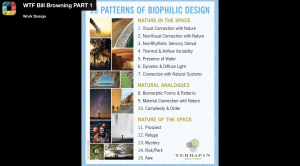 One of the great ways to sort of educate yourself about biophilic design, you can download all the publications from our website. You can also download a little postcard that has the 15 patterns of biophilic design on it, and one of the things we’ll encourage people to do as they familiar themselves with this process is to take a copy of that and go find a space that you really love and see if any of those patterns are occurring in that space. Almost inevitably there’ll be one of those patterns will be fairly strongly in that space.
One of the great ways to sort of educate yourself about biophilic design, you can download all the publications from our website. You can also download a little postcard that has the 15 patterns of biophilic design on it, and one of the things we’ll encourage people to do as they familiar themselves with this process is to take a copy of that and go find a space that you really love and see if any of those patterns are occurring in that space. Almost inevitably there’ll be one of those patterns will be fairly strongly in that space.

